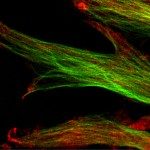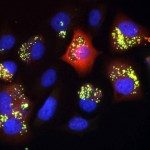Link to Pubmed [PMID] – 27189944
Link to DOI – 10.1074/jbc.M116.723676S0021-9258(20)36744-2
J Biol Chem 2016 Jul; 291(27): 13955-13963
Phosphatidyl-myo-inositol mannosyltransferase A (PimA) is an essential glycosyltransferase that initiates the biosynthetic pathway of phosphatidyl-myo-inositol mannoside, lipomannan, and lipoarabinomannan, which are key glycolipids/lipoglycans of the mycobacterial cell envelope. PimA belongs to a large family of membrane-associated glycosyltransferases for which the understanding of the molecular mechanism and conformational changes that govern substrate/membrane recognition and catalysis remains a major challenge. Here, we determined that PimA preferentially binds to negatively charged phosphatidyl-myo-inositol substrate and non-substrate membrane model systems (small unilamellar vesicle) through its N-terminal domain, inducing an important structural reorganization of anionic phospholipids. By using a combination of single-point mutagenesis, circular dichroism, and a variety of fluorescence spectroscopy techniques, we determined that this interaction is mainly mediated by an amphipathic α-helix (α2), which undergoes a substantial conformational change and localizes in the vicinity of the negatively charged lipid headgroups and the very first carbon atoms of the acyl chains, at the PimA-phospholipid interface. Interestingly, a flexible region within the N-terminal domain, which undergoes β-strand-to-α-helix and α-helix-to-β-strand transitions during catalysis, interacts with anionic phospholipids; however, the effect is markedly less pronounced to that observed for the amphipathic α2, likely reflecting structural plasticity/variability. Altogether, we propose a model in which conformational transitions observed in PimA might reflect a molten globule state that confers to PimA, a higher affinity toward the dynamic and highly fluctuating lipid bilayer.





